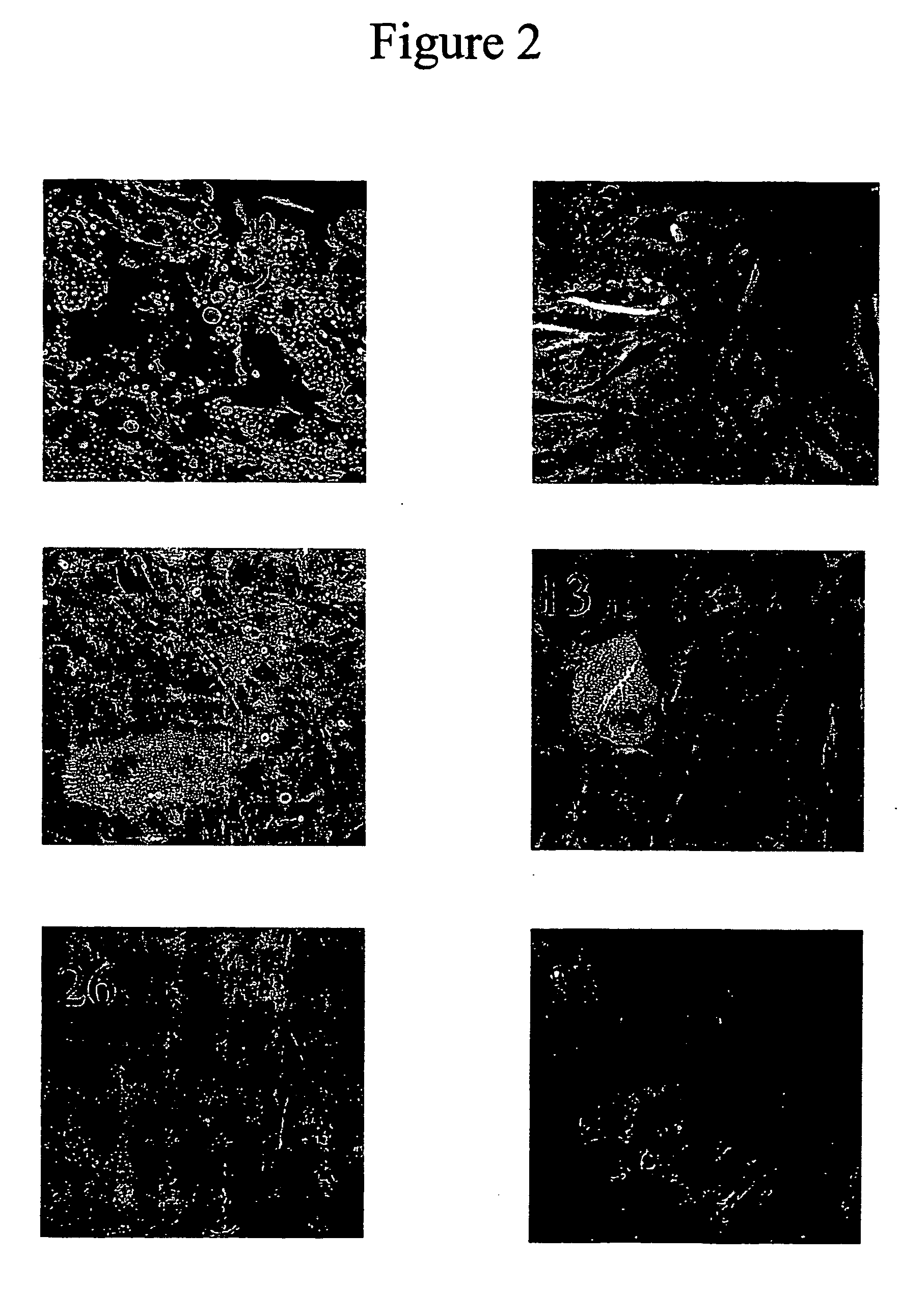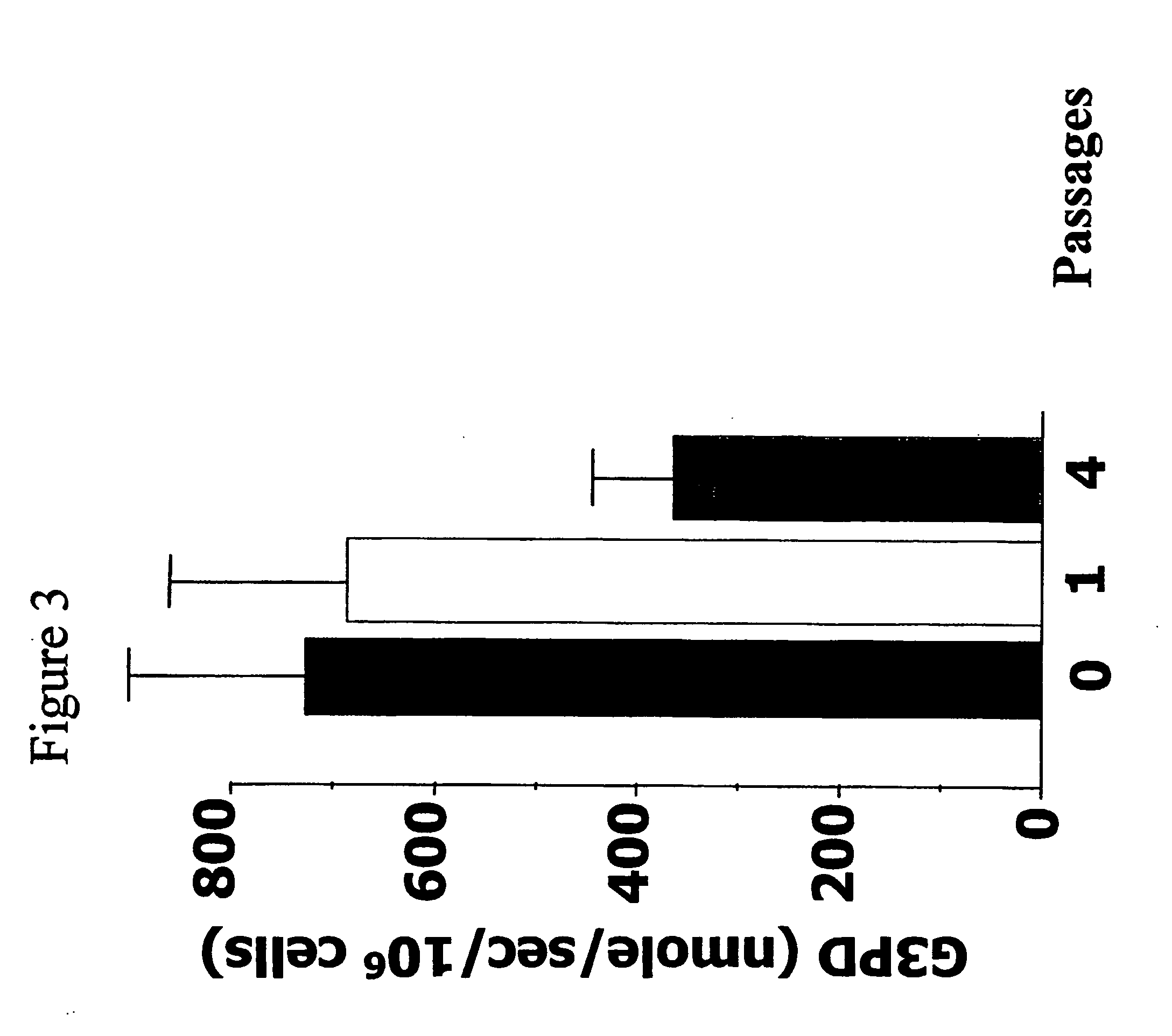Preadipocyte cell strains and uses therefore
a technology of preadipocytes and cells, applied in the field of preadipocyte cell strains, can solve the problems that wild type cultures are not capable of accumulating such substantial amounts of lipids after less than 10 days, and achieve the effect of enhancing the differentiation of passaged cells and increasing the replicative capacity
- Summary
- Abstract
- Description
- Claims
- Application Information
AI Technical Summary
Benefits of technology
Problems solved by technology
Method used
Image
Examples
example i
Restricted Replicative Potential and Declining Capacity of Primary Adipocytes
[0098] Human preadipocytes are technically difficult to isolate and culture. Moreover, as with other human cell types, the capacity of human preadipocytes to replicate (i.e., their replicative capacity) declines gradually as they are passaged. Primary, wild type abdominal subcutaneous preadipocytes were passaged at a 1:2 split ratio. The time to confluence (Tc) increased as a function of passage until cells were no longer able to achieve confluence by passage 36±3. This took over 2 years. These data are set forth in FIG. 1. The time required for primary preadipocytes to undergo the first 5 passages was 38±5 days while the time taken to progress from passage 6 to 10 was 75±14 days (N=11 different fat samples; P<0.01; paired T test). Cells were no longer capable of reaching confluence after 36±3 passages (N=3 experiments), which took over 2 years to achieve. Together with declining replicative potential with...
example ii
Characterization of Telomere Reverse Transcriptase Activity and Expression in Primary Preadipocytes and Telomerase-Transfected Preadipocytes
[0104] Initial studies were performed to determine telomere length and telomere reverse transcriptase (TERT) mRNA levels in serially passaged human preadipocytes. Southern blots of DNA from serially passaged preadipocytes showed that telomeric restriction fragment length shortens in wild type preadipocytes (FIG. 5). Preadipocyte telomerase shorten by approximately 120±44 bp per population doubling. Such decreases in telomere restriction fragment length have been reported in other cell types. These data indicate that primary preadipocytes do not contain significant human telomerase reverse transcriptase (hTERT) activity. Moreover, Northern blot analysis indicated that primary preadipocytes did not contain significant human telomerase reverse transcriptase (hTERT) mRNA after the 5th passage (FIG. 7, lane 2).
[0105] An analogous decline in telomer...
example iii
Capacity for Both Replication and Differentiation are Greatly Enhanced in Telomerase-Expressing Preadipocytes
[0108] Telomerase-expressing clones (obtained from abdominal subcutaneous preadipocytes as described above) exhibited varying capacities for replication and differentiation. Telomerase-expressing clones were capable of being passaged 39 times over a two month period, while it took wild type cells two years to achieve 32 doublings. Some telomerase-expressing clones were capable of over 50 population doublings within 4 months before occurrence of replicative arrest. FIG. 9 demonstrates that clones that stably express telomerase retain capacity to differentiate for at least about 40 population doublings, while capacity for differentiation (i.e., capacity for adipogenesis) in wild type preadipocytes declines rapidly with serial passage. A high capacity for adipogenesis after 50 doublings, to an extent generally seen only in the first 5 doublings of primary culture preadipocytes,...
PUM
| Property | Measurement | Unit |
|---|---|---|
| time | aaaaa | aaaaa |
| time | aaaaa | aaaaa |
| energy homeostasis | aaaaa | aaaaa |
Abstract
Description
Claims
Application Information
 Login to View More
Login to View More - R&D
- Intellectual Property
- Life Sciences
- Materials
- Tech Scout
- Unparalleled Data Quality
- Higher Quality Content
- 60% Fewer Hallucinations
Browse by: Latest US Patents, China's latest patents, Technical Efficacy Thesaurus, Application Domain, Technology Topic, Popular Technical Reports.
© 2025 PatSnap. All rights reserved.Legal|Privacy policy|Modern Slavery Act Transparency Statement|Sitemap|About US| Contact US: help@patsnap.com



